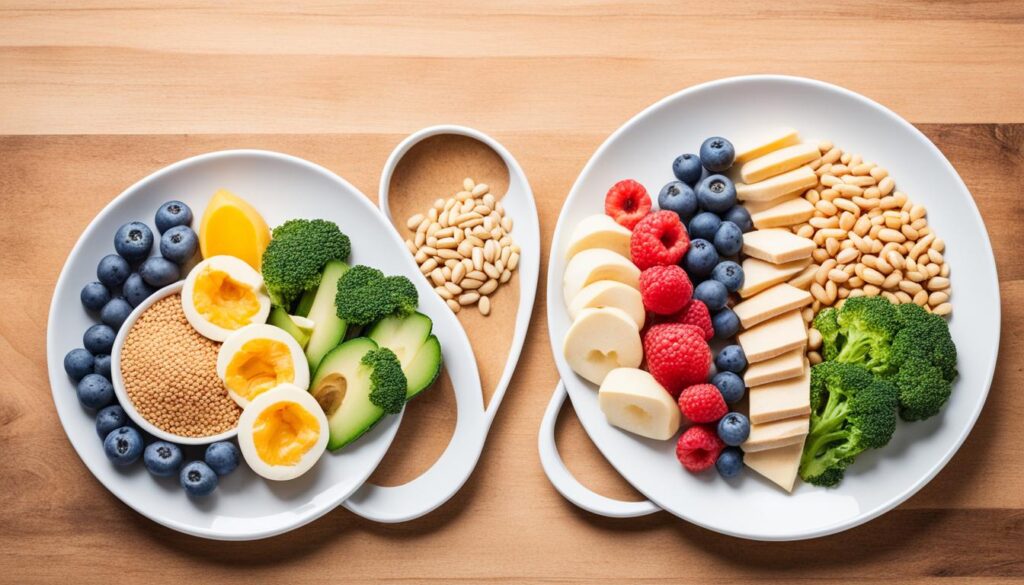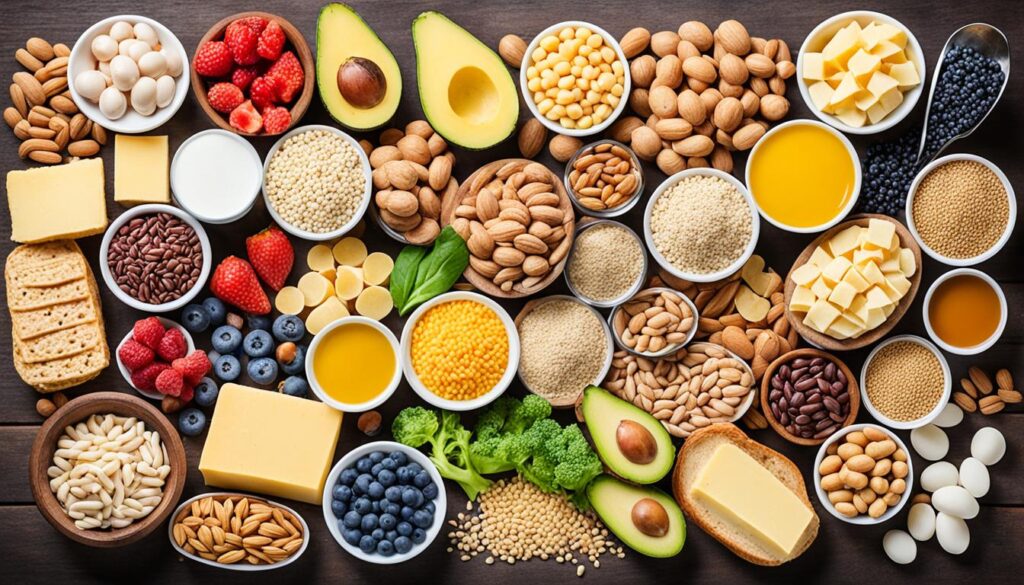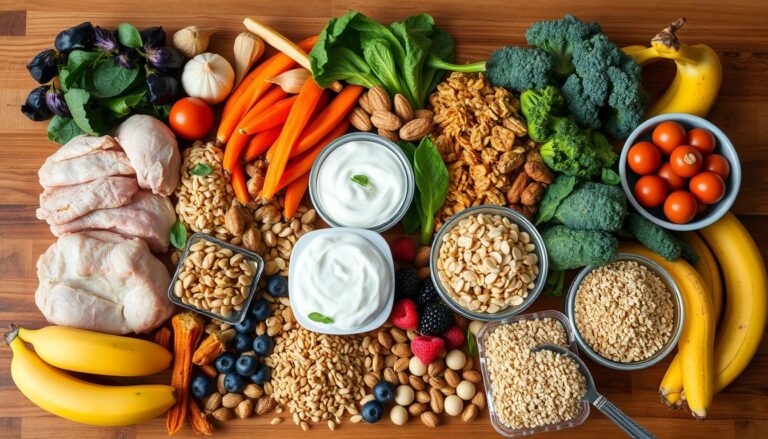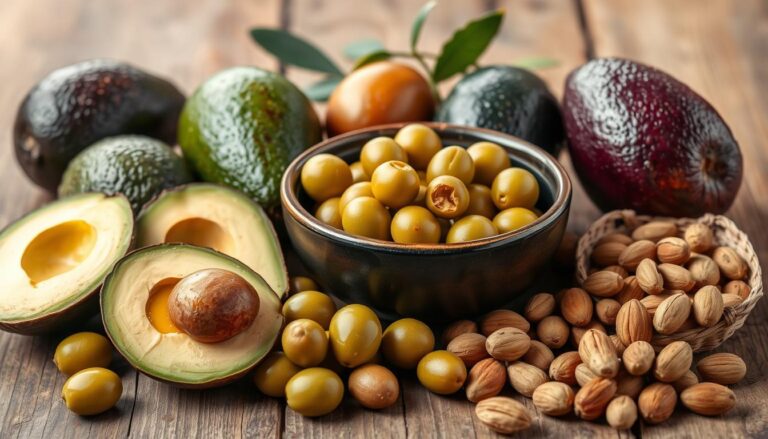Hold on, everyone, we’re diving into the world of macronutrients! Carbs, protein, fat, and fiber are the big players in our diet. They work together to give your body and mind energy and nourishment. Let’s explore how these nutrients become the superheroes of our meals.
Key Takeaways
- Carbohydrates, protein, fat, and fiber are the four essential macronutrients that provide our bodies with energy and essential nutrients.
- Understanding the unique roles and sources of these macronutrients is key to maintaining a balanced, healthy diet.
- Discovering the difference between simple and complex carbohydrates, lean and plant-based protein, healthy and unhealthy fats, and the benefits of
- can help you make informed choices.
- Mastering the art of macronutrient balance can unlock the secret to optimal health and well-being.
- Debunking common myths and misconceptions about macronutrients can empower you to make more mindful, nutritious decisions.
Ready to master macronutrients? Let’s find out how these nutrients change our health for the better.
What are Macronutrients?
Our bodies need three main types of nutrients for health and energy: carbohydrates, protein, and fat. These are called macronutrients and are crucial for our well-being.
Defining Carbohydrates, Protein, and Fat
Carbohydrates are the main energy source for our bodies. They can be simple like sugars or complex like starches and fibers. Protein builds our muscles and boosts our immune system. Fats help with hormone production, protect our organs, and are a key energy store.
The Role of Macronutrients in a Balanced Diet
To stay healthy, we need a good mix of carbohydrates, protein, and fat. If we eat too much of one and too little of the others, we might face health problems. Balancing carbohydrates, protein, and fat helps our body work well and keeps our weight in check.
Learning about the roles of each macronutrient is key. It helps us plan a diet that meets our specific needs. Next, we’ll look closely at the benefits and special notes for each macro.

Carbohydrates: The Body’s Fuel
Carbohydrates are the body’s main energy source. They help our brain work and power our actions. They come in two main types: simple and complex. Understanding them can help us pick better foods for stable blood sugar.
Simple vs. Complex Carbohydrates
Simple carbohydrates are basic sugars. They give quick energy because they’re fast to digest. Think of glucose, fructose, and lactose. Complex carbohydrates are long chains of these sugars. They take more time to break down, offering longer-lasting energy. Starch and fiber are good examples of complex carbs.
| Simple Carbohydrates | Complex Carbohydrates |
|---|---|
| Quickly digested and absorbed | Slowly digested and absorbed |
| Provide a rapid burst of energy | Deliver a steadier supply of energy |
| Examples: glucose, fructose, lactose | Examples: starch, dietary fiber |
Glycemic Index: Understanding Carb Quality
The glycemic index shows how fast carbs affect your blood sugar. High-glycemic foods, like white bread, spike blood sugar quickly. Low-glycemic foods, including whole grains, raise it slowly. Picking foods with a low index helps keep your energy steady and supports health.

Protein Power: Building Blocks of Life
Protein is the basic building block of our bodies. It’s essential for growth, repair, and keeping our tissues and organs healthy. It’s made up of amino acids. Our cells use these to build and keep everything working. This includes muscle, organs, and skin.
Many foods provide protein, which can come from animals or plants. Lean meats, poultry, fish, eggs, dairy products, and legumes are great choices for high-quality protein. But, plant-based options like tofu, tempeh, seitan, and beans are also excellent.
It’s vital to know how our bodies handle protein to make the most of it. When we eat protein, our body turn it into amino acids. These move through our body to help with many tasks. This includes building and repairing muscles, growing and maintaining tissues, and supporting the immune system.
- Muscle building and repair
- Tissue growth and maintenance
- Immune system support
- Hormone production
- Energy production
Having many different protein-rich foods in our diet is important. This way, our body gets all the amino acids it needs for good health and performance.
Protein is the foundation of our bodies. It’s key for growth, repair, and keeping us strong and healthy.
It doesn’t matter if you choose animal or plant sources for your protein. The main thing is to pick lean, high-quality sources. This choice gives your body what it needs to function well. Understanding protein helps you use it to power your success.
The Fat Facts: Not All Fats are Created Equal
There’s a lot of talk about fats, and much of it is wrong. It’s true; not all fats are the same. Some can be bad for us, while others are needed for a good diet. Let’s learn why some fats are good and others are not.
Healthy Fats: Omega-3s and Monounsaturated Fats
Omega-3 fatty acids and monounsaturated fats are the top choice in fats. These fats are great for our health, helping our hearts and brains. Omega-3s in fish and walnuts can make your heart stronger and reduce the chances of a stroke. Monounsaturated fats found in avocados, olive oil, and nuts can improve your good cholesterol and lower bad cholesterol.
Unhealthy Fats: Saturated and Trans Fats
But, saturated fats and trans fats cause problems. Saturated fats in red meat, butter, and cheese can make your cholesterol higher and heart disease risk greater. Trans fats in processed and fried food are worse. They lower your good cholesterol and raise the bad, which can harm your health.
The goal is to eat more healthy fats and less of the bad kinds. This way, you can get the good from fat without the bad effects.

Not all fats are created equal. Embrace the healthy ones, and steer clear of the harmful varieties.
Carbohydrates, protein, fat and fiber: The Macronutrient Balance
Finding the best mix of carbohydrates, protein, fat, and fiber is important. It leads to a balanced and nutrition-packed diet. Knowing how these nutrients work can aid your health and fitness goals.
Carbohydrates give us energy for movement and thinking. Proteins help us build and fix our bodies. Fats are key for making hormones, taking in nutrients, and saving energy. Don’t forget fiber, which keeps our digestion running smoothly.
Everyone’s ideal mix of these nutrients can differ. It depends on things like age, how active you are, and your health. But, according to the American Dietary Guidelines, here’s the suggested nutrient breakdown:
- Carbohydrates: 45-65% of total daily calories
- Protein: 10-35% of total daily calories
- Fat: 20-35% of total daily calories
- Fiber: 25-30 grams per day
Eating a range of healthy, whole foods is crucial for this balance. Include:
- Whole grains for complex carbohydrates
- Lean proteins like chicken, fish, and legumes
- Healthy fats from avocados, nuts, and olive oil
- High-fiber fruits, vegetables, and whole-grain breads and cereals
Watch the nutrients in your meals and snacks to build a healthy eating plan. This supports your well-being.
| Macronutrient | Function | Recommended Daily Intake |
|---|---|---|
| Carbohydrates | Primary source of energy | 45-65% of total calories |
| Protein | Building and repairing tissues | 10-35% of total calories |
| Fat | Hormone production, nutrient absorption, energy storage | 20-35% of total calories |
| Fiber | Digestive health and regularity | 25-30 grams per day |

Achieving the right macronutrient balance is like finding the sweet spot for your body – it’s not about perfection, but about finding what works best for you.
Fiber: The Underrated Nutrient
Fiber may be an unsung hero, but it’s crucial for our health. It keeps our digestive system working well and supports our overall well-being. We will learn about soluble and insoluble fiber. And find out how to get more of this important nutrient.
Soluble vs. Insoluble Fiber
There are two types of fiber: soluble and insoluble. Soluble fiber turns into a gel-like material in water. This slows down how your body absorbs nutrients. It’s great for helping to control blood sugar and cholesterol. Insoluble fiber doesn’t dissolve in water. It helps your stool stay bulky, which is important for regular bowel movements.
| Soluble Fiber | Insoluble Fiber |
|---|---|
| Dissolves in water | Does not dissolve in water |
| Slows nutrient absorption | Adds bulk to stool |
| Helps regulate blood sugar and cholesterol | Promotes regular bowel movements |
| Examples: oats, beans, apples | Examples: whole grains, vegetables, nuts |
Fiber’s Role in Digestive Health
Fiber keeps our digestive system healthy in many ways. Insoluble fiber makes our stool bulkier. This helps with regular bowel movements and prevents constipation. It may even lower the risk of certain digestive issues like diverticulitis. Soluble fiber works to relieve IBS symptoms. It does this by helping with nutrient absorption and keeping blood sugar levels steady.
Fiber is like the unsung hero of the nutrient world. It may not get the same attention as protein or healthy fats, but it’s crucial for keeping your digestive system running smoothly.
To hit your daily fiber goal, try to get 25-30 grams each day. You can do this by eating plenty of fruits, vegetables, whole grains, and legumes. Including both soluble and insoluble fiber in your diet supports digestive and overall health.

Whole Foods: The Best Sources of Macronutrients
Eating a balanced diet is important for our health. It’s not only about how much we eat, but also where our food comes from. For the best health results, we should get our nutrients from whole foods. This means natural, unprocessed foods.
Whole Grains: Complex Carbohydrate Powerhouses
Whole grains like whole wheat, brown rice, quinoa, and oats are very rich in carbs. They also have lots of fiber, vitamins, minerals, and plant compounds. These whole foods can keep you full, help control your blood sugar, and are good for your heart and gut.
Lean Protein Sources: Building Blocks of the Body
For protein, choose lean meats, poultry, fish, eggs, legumes, and nuts. They offer not just protein but also healthy fats, vitamins, and minerals. Adding various lean proteins to your diet supports your muscle and body health.
Healthy Fats: The Unsung Heroes
Not all fats are bad. Foods like avocados, nuts, seeds, and fatty fish carry healthy fats like monounsaturated and omega-3. These whole foods are great for your heart, mind, and reducing inflammation. They offer more benefits than just fats.
Focusing on whole food macronutrients ensures you get important nutrients and plant compounds. This supports your health and well-being in many ways.

The best way to get the nutrients your body needs is to eat a wide variety of whole foods.
Reading Food Labels: Decoding Nutrient Information
Understanding nutrition labels can be tricky, but don’t worry. With the right tips, you’ll shop like a pro. We’ll focus on what matters most when you read food labels and learn to spot hidden facts.
Understanding Portion Sizes
Knowing the serving size is key. It shows how much is in each portion, helping you know what you’re eating. Remember, the listed size might be more or less than what you usually consume.
- Serving size is usually in familiar units like cups or pieces.
- Compare the serving size to what you actually eat to manage your intake.
- Stay aware, serving sizes between similar items can differ greatly.
Figuring out serving sizes guides your food choices wisely.
Macronutrient Breakdown
The nutrition facts inform you about carbs, protein, and fat. This knowledge is essential for picking foods that meet your health needs.
- Focus on the carbohydrates and know the difference between simple and complex carbs.
- Protein info lets you see how much is for muscle building and maintenance.
- For fats, identify the healthy kinds to make better dietary choices.
By understanding these details, you will select food that supports your health.

Decoding food labels is the key to making informed, healthy choices at the grocery store.
Don’t overlook the info on food labels. It’s there to help you make smart purchases. Give it a read, and you’re on your way to better eating decisions.
Meal Planning: Balancing Macronutrients
Making a well-balanced meal is like creating art. It requires you to think carefully. You need to know about macronutrients. That’s carbohydrates, protein, and fat. This knowledge helps you make dishes. These dishes feed your body well and taste good. The key is to find the best mix of these nutrients that meets your needs.
Personalized Nutrient Needs
Everyone is different. So, your meal plan should be unique. Things like how old you are, how active you are, your health goals, and what you like to eat matter. They help decide the best amount of carbs, protein, and fat for you. You can work with a dietitian or use online tools to figure this out.
For example, if you exercise a lot, you might need more carbs to keep you going. But, if you’re watching your blood sugar, you might do better with fewer carbs and more protein. By making a meal plan just for you, your body will get exactly what it needs.
| Macronutrient | Importance | Recommended Intake* |
|---|---|---|
| Carbohydrates | The body’s primary source of energy | 45-65% of total daily calories |
| Protein | Builds and repairs tissues, supports immune function | 10-35% of total daily calories |
| Fat | Supports hormone production, brain health, and nutrient absorption | 20-35% of total daily calories |
*Recommended intakes may vary based on individual needs and health conditions.
The key to a balanced diet is not deprivation, but rather embracing a variety of nutrient-dense whole foods that energize your body and delight your palate.
Focus on what your body needs and the right balance of nutrients. This way, you will make a meal plan that fits you perfectly. Try new things and find out what you love. Soon, you’ll be on the path to a healthier, tastier life.
Myths and Misconceptions about Macronutrients
In the nutrition world, macronutrients are often misunderstood. People have wrong ideas about carbohydrates, proteins, and fats. This can cause confusion and lead to bad food choices. Let’s clear up some of these macronutrient myths.
Some think all carbs are bad, but that’s not true. Yes, refined carbs can cause problems. Yet, carbs from fruits, veggies, and whole grains are crucial. They give us lasting energy and help us stay healthy.
Another myth involves protein being only for athletes or those who lift weights. The truth is, protein is important for everyone. It helps with repairing tissues and keeping our immune system strong. It even helps maintain muscle, whether you exercise a lot or not.
- Myth: Eating fat makes you fat.
- Fact: The type of fat is crucial. Healthy fats in foods like avocados, nuts, and olive oil are good for your weight and health.
Many believe they should eat the same amount of each nutrient. But, the best mix varies from person to person. Factors like what you do, your health goals, and what you like play a big role.
| Myth | Fact |
|---|---|
| Carbohydrates are always bad for you. | Complex carbohydrates from whole foods are essential for energy and overall health. |
| Protein is only for bodybuilders. | Protein is a vital macronutrient for everyone, supporting tissue repair, immune function, and lean muscle mass. |
| Eating fat makes you fat. | The type of fat is more important than the amount. Healthy fats can support weight management and overall health. |
| All macronutrients should be consumed in equal proportions. | The optimal balance of macronutrients can vary based on individual factors, such as activity level, health goals, and personal preferences. |
Learning about macronutrient myths can help you make better food choices. A balanced diet, full of whole foods, is key to good health. It should focus on nutrient-rich carbs, proteins, and fats.
Nutrient Timing: When to Eat What
Eating nutrients at certain times affects how your body uses them. For better results from carbs, protein, and fat, time your meals wisely. This can help you reach your health and fitness goals.
Let’s dive into the idea of nutrient timing. We’ll see when it’s best to eat carbs, proteins, and fats.
Carbohydrates: Fuel for Performance
Carbs are key for energy. Eat complex carbohydrates like whole grains, fruits, and veggies before and during exercise. They give your muscles fuel and keep you going strong.
Protein: Building and Repairing
For building and repairing muscles, protein is a must. The best time for high-quality protein is within 30 minutes after you exercise. This helps your body use it faster for muscle repair.
Fats: Fuel for the Long Haul
Healthy fats found in nuts, avocados, and olive oil offer lasting energy. Adding these to your meals can make you feel full longer. They also provide steady energy all day.
When you eat your macronutrients matters, not just which ones. Aligning your meals with your body’s natural rhythm is important. It helps you fully benefit from the nutrients, aiding your health and fitness journey.
Proper nutrient timing can make the difference between a good workout and a great one. – Fitness Expert, Jane Doe
Conclusion
As our dive into macronutrients wraps up, their vital role is crystal clear. Carbohydrates, protein, fat, and fiber form the base of a healthy diet. Knowing how they work and finding the right mix is key to lasting energy, great health, and reaching your goals.
Keep in mind, the best macronutrient mix is unique to you. It depends on your body, what you do, and what you need. Don’t be afraid to try new things. Serach for the balance that makes you feel fantastic.
As you push towards being healthier and livelier, remember these tips. Eat a variety of nutritious whole foods. Let macronutrients show you how to be your best. May your future be full of energy, health, and a love for a balanced diet.





